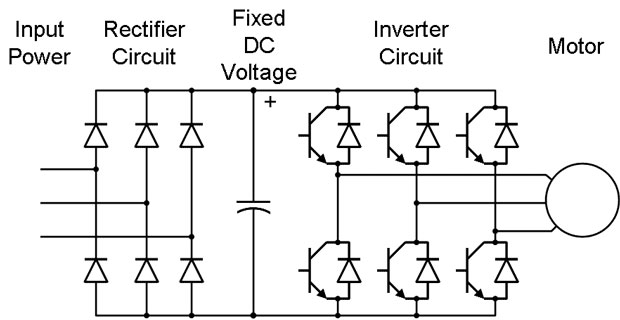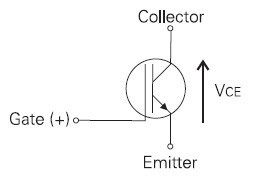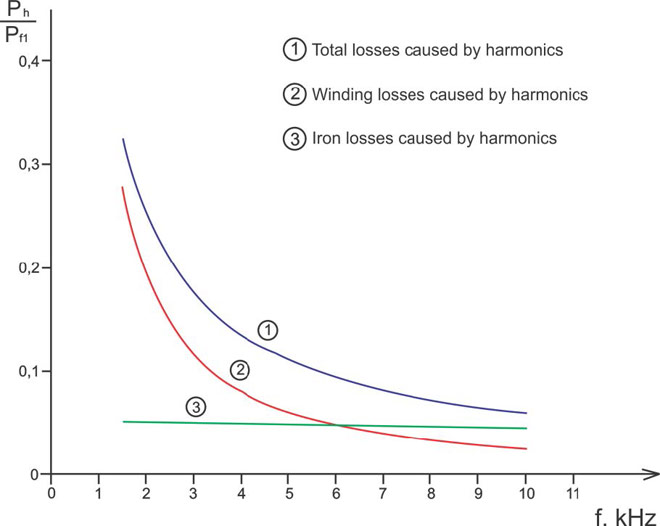Advantages of Vector VFD
Vector VFDs provide all the benefits and advantages of VVVF VFDs and more.
Start with all the advantages of VVVF VFDs:
Compared with DC drives, a vector VFD's high power factor, high-speed capability, and the ability to use induction motors are important advantages. Unlike brushless VFDs, which have been sold as replacements for DC drives, vector VFDs do not need specially-designed motors with permanent magnet rotors.

The figure shows some comparisons among vector VFDs and other technologies. This data may vary somewhat by manufacturer, but nonetheless provides general guidelines.
Pricing for AC vector VFDs is competitive with DC VFDs in applications below 50 HP. Vector VFDs are often more expensive than DC drives in larger ratings, primarily due to the more expensive power semi-conductors found in AC VFD. The lower cost of AC motors offsets some of this difference, though. Application considerations may also justify a premium for vector VFDs in those cases where the initial cost is higher.
Start with all the advantages of VVVF VFDs:
- Use "standard", low-cost, induction motors. Explosion-proof motors and other special construction is widely available. Brushes, commutators, or special "permanent-magnet' rotors are not required.
- High-input displacement power factor (about 95%), for lower-cost power.
- Some inherent ability to "hold back" loads through regeneration without extra hardware.
- High-speed capability (6,000 RPM is easily attainable).
- Closed-loop speed regulation to 0.01%.
- High-dynamic response of greater than 50 radians/second.
- Smooth low-speed operation, even under changing loads.
- High breakaway torque (150% or even 200% is common).
- Linear torque control for positioning or tension.
Compared with DC drives, a vector VFD's high power factor, high-speed capability, and the ability to use induction motors are important advantages. Unlike brushless VFDs, which have been sold as replacements for DC drives, vector VFDs do not need specially-designed motors with permanent magnet rotors.

The figure shows some comparisons among vector VFDs and other technologies. This data may vary somewhat by manufacturer, but nonetheless provides general guidelines.
Pricing for AC vector VFDs is competitive with DC VFDs in applications below 50 HP. Vector VFDs are often more expensive than DC drives in larger ratings, primarily due to the more expensive power semi-conductors found in AC VFD. The lower cost of AC motors offsets some of this difference, though. Application considerations may also justify a premium for vector VFDs in those cases where the initial cost is higher.
Post a Comment:
You may also like:
Featured Articles
Variable frequency drive Rectifier
 To understand variable frequency drive (VFD) better, it's necessary to explain some of the main parts of the variable frequency ...
To understand variable frequency drive (VFD) better, it's necessary to explain some of the main parts of the variable frequency ...
 To understand variable frequency drive (VFD) better, it's necessary to explain some of the main parts of the variable frequency ...
To understand variable frequency drive (VFD) better, it's necessary to explain some of the main parts of the variable frequency ...What is VFD, How it works? - VFD ...
 VFD is shorted for Variable Frequency Drive (also known as AC Drives and Inverters) -- that's used to make an AC motor working in ...
VFD is shorted for Variable Frequency Drive (also known as AC Drives and Inverters) -- that's used to make an AC motor working in ...
 VFD is shorted for Variable Frequency Drive (also known as AC Drives and Inverters) -- that's used to make an AC motor working in ...
VFD is shorted for Variable Frequency Drive (also known as AC Drives and Inverters) -- that's used to make an AC motor working in ...VFD: Insulated Gate Bipolar Transistor ...
 IGBT (insulated gate bipolar transistor) provides a high switching speed necessary for PWM VFD operation. IGBTs are capable of ...
IGBT (insulated gate bipolar transistor) provides a high switching speed necessary for PWM VFD operation. IGBTs are capable of ...
 IGBT (insulated gate bipolar transistor) provides a high switching speed necessary for PWM VFD operation. IGBTs are capable of ...
IGBT (insulated gate bipolar transistor) provides a high switching speed necessary for PWM VFD operation. IGBTs are capable of ...VFD controlled Induction motor ...
 This paper presents a procedure to measure the efficiency on an induction motor fed by a VFD by the all operation range to speed ...
This paper presents a procedure to measure the efficiency on an induction motor fed by a VFD by the all operation range to speed ...
 This paper presents a procedure to measure the efficiency on an induction motor fed by a VFD by the all operation range to speed ...
This paper presents a procedure to measure the efficiency on an induction motor fed by a VFD by the all operation range to speed ...Three phase inverters
 In the variable frequency drive rectifier paper, it explains how to go from three phase alternating current voltage to a direct ...
In the variable frequency drive rectifier paper, it explains how to go from three phase alternating current voltage to a direct ...
 In the variable frequency drive rectifier paper, it explains how to go from three phase alternating current voltage to a direct ...
In the variable frequency drive rectifier paper, it explains how to go from three phase alternating current voltage to a direct ...
VFD manufacturers
